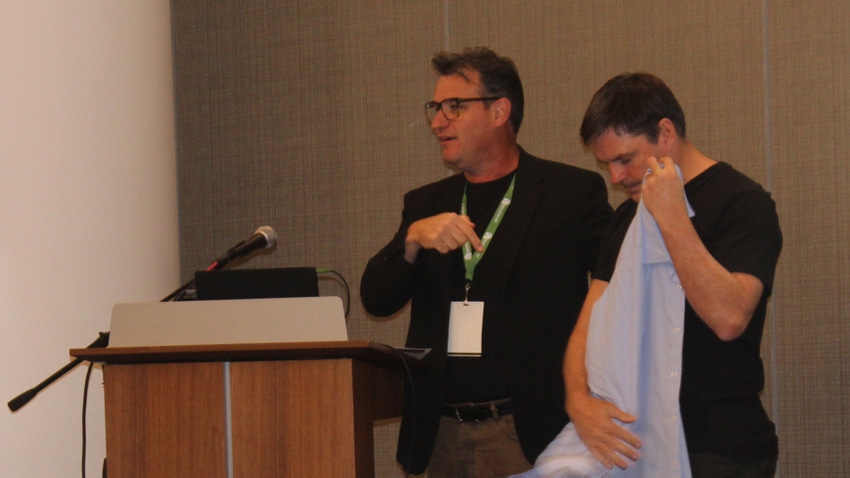March 29, 2024

For years cotton producers were urged to look for the Seal of Cotton logo on their shirts or underwear or sheets and towels to make sure they were made from cotton grown in the United States of America.
The logo doesn’t appear as much anymore because the U.S. textile and apparel industry has been decimated by imports from the People’s Republic of China and other countries that don’t feel the need to promote the use of cotton fabrics.
That loss of identity may be changing, however, because of relatively new technology that can help clothing retailers, consumers and others determine not only the country of origin for the raw material that went into fabrics but also the region, the county or district and even the farm where it was grown.
Technology development
The technology has been developed by FibreTrace Technologies, a company co-founded by David Statham, an innovative cotton producer from New South Wales, Australia. He and Shannon Mercer, CEO of FibreTrace, were speakers at the Mid-South Farm and Gin Show in early March.
“When I talk to farmers, they think it all stops after they gin and ship their cotton, and once upon a time maybe that was true,” said Mercer. “But the value you bring to brands, particularly with what’s happening in legislation, is that you can actually start to get market share back by telling the story of the good work you do on your farm.”
FibreTrace was founded in 2018 after Statham and Mercer had begun to think about how they could better tell the story of the regenerative farming practices Statham and his wife, Danielle, were using on their farming operation.
“We built FibreTrace with a team of supply chain experts and through our own individual foresight after realizing that even the most conscious suppliers were unable to guarantee complete custody of supply and recognized an emerging conversation of transparency in the supply chain,” said Mercer.
Traceability
Consumers have become more interested in where their food comes from and how farmers were growing it. Members of the European Union and other countries have issued regulations on what can be used on food products.
“We’re starting to see that now in fiber,” said Mercer. “If they buy a garment that says it’s 100% made in the USA, they want to make sure that that cotton is from the USA.
“At the same time, there’s been some big legislation, particularly in this country, which includes the UFLPA,” he said. (The Uyghur Forced Labor Prevention Act is a U.S. law that prohibits the importation of goods made with forced labor in the Xinjiang Uyghur Autonomous Region of China.)
“That’s why this convergence of traceability solutions has come about in the last six months, and why brands are starting to understand traceability and look at how they can start to come further downstream,” he noted.
“What we’re seeing through this legislation is they not only need to know the proof of provenance, but they also need to know what region it comes from. And this is where farmers can start to differentiate themselves and create the value that brands need.”
Under UFLPA, an estimated 631 brands have had their shipments stopped, he said, “That’s $30 million to $40 million worth of product sitting offshore, So, if you are a brand, that’s a very expensive exercise if you can’t tell where your cotton is coming from.”
FiberTrace uses
The technology FibreTrace is using started with paper and is the same technology that is used in U.S. bank notes and other currencies. When Statham and Mercer began looking for technology that could be used to verify where cotton is produced, the International Cotton Association introduced them to an inventor, Paul Stenning, who was looking at how to move the tracing technology from paper to fiber.
The next hurdle “was how we were able to get it out of paper and then into a fiber to withstand all the different processes that happen in manufacturing and be able to track it right through the supply chain into the warehouse, a garment, recycle and reuse,” he said.
“We started with cotton, then moved into all natural fibers and manmade fibers. The business ramped up from there to the point that we were tracking our own cotton in Australia. And now we’re marking cotton here in the U.S.”
The FibreTrace technology was applied on 15,000 bales of cotton at the Cherokee Gin and Cotton Co., in Centre, Ala., and the Graves Gin Corporation in Rector, Ark., in 2023, using the luminescent pigment that is at the center of the identification process.
The pigment reflects a spectrometry that is unique to the fiber that’s treated with it. “The way I try to explain it is it’s like a firecracker exploding in the night,” Mercer said. “You see all the different colors, and as the color dissipates back into black, we measure the distance and the time it takes for that light to go out. We can then narrow that scope to determine what the individual signature is for that fiber type.”
FibreTrace uses scanners that can be placed throughout the supply chain and measure in real time that the fiber is still the fiber. As it moves throughout the process it can also tell if something’s been blended with the original fabric.
“We lose that signal. If you put it in the cotton gin here in the U.S. you’ve got 100% of the signature. When you’re in China or you’re in Brazil or India and you mix it, that signal is no longer 100%. We can alert the brand that something's happened, and they can get in early and fix it before they end up having that $30 million or more of product sitting off the port”
About the Author(s)
You May Also Like






